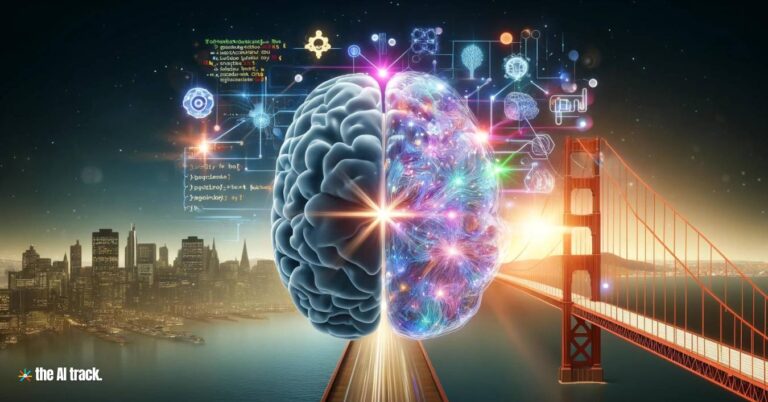Updated December 4, 2023
While Most Americans Are Aware of ChatGPT, Few Have Tried It, Pew Research Center Survey Finds
AI adoption is not what one might expect. A recent survey by the Pew Research Center has shown light on a fascinating paradox: Despite high public awareness, there remains a significant gap in actual usage among Americans – people are aware of the AI-powered chatbot ChatGPT, but few people actually use it.

Public Awareness and Familiarity
The Pew Research Center’s August 2023 survey reveals that a vast majority of Americans (90%) have heard at least a little about AI, yet only one-third are deeply familiar with it.
This aligns with earlier findings from The AI Track, which noted that 58% of U.S. adults are aware of ChatGPT. The chatbot has made a significant impact on public consciousness, attracting attention for its remarkable capabilities. This AI marvel has become a buzzword in technology discussions and has been featured in numerous articles, blogs, and social media platforms.
The AI adoption Gap: Exploring the Disconnect
Despite AI’s and ChatGPT’s wide recognition, both surveys reveal a considerable gap between awareness and actual AI adoption. Only 14% of the respondents in The Pew Research Center’s March 2023 survey, reported trying out the chatbot themselves. In the The Pew Research Center’s August 2023 survey this percentage was 18%.
This discrepancy raises intriguing questions about the factors influencing user behavior and the barriers to widespread adoption.
It is possible that people are aware of ChatGPT but do not use it because they do not know how to use it, or because they do not see the value in using it. It is also possible that people are using ChatGPT but do not realize that it is AI-powered.
Another possibility for such a low AI adoption percentage is that people are using ChatGPT but do not consider it to be “real” AI. This is because ChatGPT is a large language model, which means that it is trained on a massive dataset of text and code.
ChatGPT can generate text, translate languages, write different kinds of creative content, and answer your questions in an informative way. However, ChatGPT does not have the ability to understand and respond to the world in the same way that a human does.
It is also worth noting that ChatGPT is still under development. This means that it is not perfect and it can make mistakes. As a result, some people may be hesitant to use ChatGPT for important tasks.
Demographic Differences in AI Adoption
Demographic Differences in AI Adoption
The Pew Research Center’s survey from March 2023 reveals specific demographic trends in AI adoption and identifies specific demographic groups that show a higher inclination toward using ChatGPT (AI adoption):
- Men: The survey indicates that men are more likely to adopt this AI chatbot than women. The reasons behind this gender disparity merit further exploration.
- Adults Under 30: Younger adults have shown a greater affinity for engaging with ChatGPT. The allure of novelty and curiosity might be contributing factors.
- Higher Education and Income Levels: U.S. adults with a higher level of education and income are more willing to embrace this technology, possibly due to their exposure to AI applications in various fields.
Pew Research Center’s survey from August 2023 notes that only 30% of U.S. adults can correctly identify all six examples of AI in everyday life, with a higher recognition rate among adults with college or postgraduate degrees, again underscoring a link between educational level and AI literacy.
AI in Education and the Workplace
In the realm of education, the Pew Research Center’s fall 2023 survey found that 67% of U.S. teens are familiar with ChatGPT, with 19% using it for school-related purposes. There is a notable divide in the acceptance of ChatGPT’s use, with 69% of teens considering it acceptable for research, but 57% finding it unacceptable for essay writing.
Regarding AI in the workplace, the Pew Research Center’s December 2022 survey indicates that 19% of American workers are in occupations highly exposed to AI, primarily in higher-paying sectors requiring college degrees and analytical skills.
The survey also highlights a significant expectation among 62% of Americans that AI will greatly impact workers, though fewer (28%) anticipate a personal major impact. There is substantial resistance to the use of AI in hiring and worker monitoring, with 66% opposing AI assistance in hiring decisions
Insights and Breakthroughs
The surge in ChatGPT’s user base, reaching an astonishing 100 million users within a mere two months of its launch, has made headlines across the tech world. This rapid growth signifies the enormous potential of AI-powered chatbots and the appetite for such interactive experiences.
However, the survey’s findings also underscore the importance of bridging the gap between awareness and AI adoption. While the reasons for low uptake among U.S. adults are not explicitly stated, they present a unique opportunity for developers, marketers, and AI enthusiasts to explore ways to make AI chatbots like ChatGPT more appealing and accessible to a broader audience.
As AI continues to develop and become more sophisticated, it is likely that we will see a greater adoption of AI-powered tools like ChatGPT. However, it is important to remember that AI is still a relatively new technology. It will take time for people to learn how to use AI effectively and to trust AI to perform important tasks.
Key Takeaways
- Awareness vs. Usage Gap: High awareness of ChatGPT and AI doesn’t necessarily translate into widespread usage.
- Demographic Differences: Men, younger adults, and those with higher education are more inclined towards using AI technologies like ChatGPT.
- Educational and Workplace Application: AI is seen as a tool for research in education but faces resistance in tasks like essay writing and employee surveillance.





